
Amoeba
Overview
Amoeba is a genus
of Protozoa
.
History=
The amoeba was first discovered by August Johann Rösel von Rosenhof
in 1757. Early naturalists referred to Amoeba as the Proteus animalcule after the Greek
god Proteus
, who could change his shape. The name "amibe" was given to it by Bory de Saint-Vincent, from the Greek amoibè (αμοιβή), meaning change. Dientamoeba fragili was first described in 1918, and was linked to harm in humans.
The cell's organelle
s and cytoplasm
are enclosed by a cell membrane
; it obtains its food through phagocytosis.
Genus
In biology, a genus is a low-level taxonomic rank used in the biological classification of living and fossil organisms, which is an example of definition by genus and differentia...
of Protozoa
Protozoa
Protozoa are a diverse group of single-cells eukaryotic organisms, many of which are motile. Throughout history, protozoa have been defined as single-cell protists with animal-like behavior, e.g., movement...
.
History=
The amoeba was first discovered by August Johann Rösel von Rosenhof
August Johann Rösel von Rosenhof
August Johann Rösel von Rosenhof was a German miniature painter, naturalist and entomologist. With his accurate, heavily detailed images of insects he was recognised as an important figure in modern entomology.-Life:Descendant of a "noble family of Austria", Rösel was born August Johannes Rösel...
in 1757. Early naturalists referred to Amoeba as the Proteus animalcule after the Greek
Greek mythology
Greek mythology is the body of myths and legends belonging to the ancient Greeks, concerning their gods and heroes, the nature of the world, and the origins and significance of their own cult and ritual practices. They were a part of religion in ancient Greece...
god Proteus
Proteus
In Greek mythology, Proteus is an early sea-god, one of several deities whom Homer calls the "Old Man of the Sea", whose name suggests the "first" , as protogonos is the "primordial" or the "firstborn". He became the son of Poseidon in the Olympian theogony In Greek mythology, Proteus (Πρωτεύς)...
, who could change his shape. The name "amibe" was given to it by Bory de Saint-Vincent, from the Greek amoibè (αμοιβή), meaning change. Dientamoeba fragili was first described in 1918, and was linked to harm in humans.
The cell's organelle
Organelle
In cell biology, an organelle is a specialized subunit within a cell that has a specific function, and is usually separately enclosed within its own lipid bilayer....
s and cytoplasm
Cytoplasm
The cytoplasm is a small gel-like substance residing between the cell membrane holding all the cell's internal sub-structures , except for the nucleus. All the contents of the cells of prokaryote organisms are contained within the cytoplasm...
are enclosed by a cell membrane
Cell membrane
The cell membrane or plasma membrane is a biological membrane that separates the interior of all cells from the outside environment. The cell membrane is selectively permeable to ions and organic molecules and controls the movement of substances in and out of cells. It basically protects the cell...
; it obtains its food through phagocytosis.
Unanswered Questions

